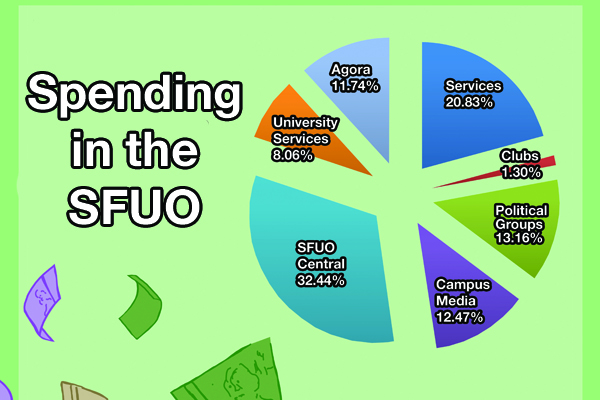We hear all about the SFUO, but do we really know where our money goes?
Infographic by Tina Wallace
Dave Eaton, an international development student in the last year of his studies at the U of O, carries a heavier load of responsibility than the average 24-year-old. He’s the overseer of a multi-million dollar government with the population of a small city: the Student Federation of the University of Ottawa (SFUO).
He started his career with the SFUO on the administrative side of things as a board representative, and in February 2013 he was elected vp finance as a member of the Student Action slate.
Eaton’s work over the 2013–14 year has paid off. During the February student union elections, he ran as the incumbent candidate and won. He’s now nearing the start of his second mandate on May 1 and will continue to manage the finances of the student union until the end of April 2015.
The SFUO is a large, complex organization that fulfills a number of functions on campus. While the management of the union typically changes hands year to year as a new executive committee is elected — generally composed of a president, and five vice-presidents that handle finance, communications and services, equity on campus, social events, and university affairs — the roles and responsibilities of the executive remain relatively consistent.
Among the priorities of the executive, the tasks include providing social programming, services, and campaigns that matter to students. In a management capacity, the executive also strives to ensure SFUO businesses are well-managed and that services are well-supported, and to respond to the needs of students.
Breaking it down
While the executive committee has some control over where the $1.7-million central SFUO budget goes, the majority of student fees are constitutionally divided up into different levies, in an amount totaling more than $4.3 million in 2013–14.
Groups such as the Canadian Federation of Students (CFS), campus media, and services that are jointly funded by the SFUO and the university, like the Student Academic Success Services (SASS) Career Services, are funded by student levies.
The levy is a lump sum payment per student that provides the minimum budget of an organization. In the case of full-time students enrolled in the 2014 winter semester, the total amount of money collected per person is $87.69. Included in this total is the central SFUO levy ($26.60 per student in the winter 2014 semester), a gross fund that finances the SFUO’s social, campaigns, and promotions departments, as well as its federated bodies (student associations). This fund is often drawn upon to provide extra finance to clubs or services as well.
Levies are established as a democratic mechanism to ensure student spending is approved by the general student body rather than being at the discretion of the executive year to year. Each time a student levy is passed, that amount of funding is added permanently to student tuition bills to ensure a service continues to get funding.
Adam Gilani, a fourth-year public administration and political science student, served as vp finance of the SFUO for the 2012–13 year. He believes the current SFUO levy system is problematic in its lack of flexibility, as the student body doesn’t currently approve the levies.
“Some of these service centres were established in the ‘90s, so it’s been 20 to 25 years of these service centres and we’re still running on that same initial question,” he said. “We don’t know what was actually voted on, we don’t know what students actually voted for, because we don’t have it in writing.”
According to Gilani, a better system would be one in which referenda are held every eight years or so to adjust the amount of funding given to different organizations.
“There are certain service centres that maybe need more money, and some that maybe need less money, but we haven’t had the opportunity to ask those question again” he said. “Are there service centres that maybe need to be reformulated? Maybe they’re not exactly serving the students in the best way possible.”
Eaton also recognizes the difficulties involved in the SFUO levy system, but points out certain advantages to having consistent budgets year to year. Because they’re working within the same budget every year, the people who balance the books for these services become very good at maximizing what students are paying for.
Where does our money go?
The SFUO’s mandate spans the whole of its 35,000-plus student community. While the union’s budgetary expenses are targeted at its entire membership, there are some areas that generally have more impact on the average student than others.
Eaton cited the U-Pass program, the student health and dental plan, student political campaigns, social events, and clubs as the most impactful areas.
The health plan and U-Pass programs are listed separately from the SFUO’s fees in a student tuition bill. This is because the SFUO administers the two programs but simply acts as an intermediary for the payments — none of those fees ever enter the union’s bank account. However, administration fees are taken from the central fund, used to cover expenses like funding the distribution of the passes, providing administrative support for students throughout the year, and working with OC Transpo to continue the program from year to year. The planned budget for 2014 proposed by Eaton and available on the SFUO website states $65,000 from the central fund was intended to be used for the U-Pass.
“The U-Pass is a massive program we provide, so I think student money going to that is beneficial for all students,” said Eaton.
The health plan has an opt-out option for those who already have coverage, but Eaton said more than 60 per cent of U of O students choose to stay.
Some of the money also goes to the CFS, one of the largest student organizations in Canada. It’s a body that tackles issues with the treatment of graduate and Aboriginal students, tuition fees, and other problems that students face.
In the winter 2014 semester, $4.26 per student was paid to the national CFS and $3.55 per student was paid to its Ontario division, totaling $290,551 and $242,125 respectively. Eaton sees the payment of these fees as extremely important to student life at the U of O.
“One of the student union’s main roles is to represent students at the table at the admin level, provincial level, and federal level, and by working with our campaigns department and other students, being able to lobby the government and not just being a single voice at the University of Ottawa,” he said.
He also cited health coverage for international students and the removal of ancillary fees as two issues that have come up at the CFS level in the past, and said students often don’t understand the impact of these fees.
“I think some people might not see the benefit in supporting those campaigns, but by simply existing as a student union we sort of provide a voice for students, being able to protect them at all levels,” he said.
The Agora, a student-run bookstore downtown, is a commonly discussed topic among students; conversation normally focuses on the high levy that goes to this service — a total of $10.29 per student this semester— and whether it’s worthwhile to spend this amount on the service.
According to the SFUO’s books, the Agora turned a profit of $246,799 in the 2012-13 school year. But some students say their levies aren’t necessarily paying off.
“You get back what you pay into the levy — the levy acts as an upfront to make all the necessary purchases for the year, but in the long run students are still saving money across the board because even by existing it’s driving down the cost at the university bookstore here,” said Eaton. “At Carleton, where they don’t have a student-run bookstore, the cost of the books at the university bookstore there are about 10 to 20 per cent higher than they are at the university bookstore here.”
Keeping an eye on things
The SFUO is set up to keep student money under the watchful eyes of the executive. On the service side of things, Eaton said there are often misconceptions.
“I think people sometimes think the services just get to blow their budgets, but for each service there’s an executive who’s the supervisor or manager of the service,” he said.
In terms of executive management, outside the role of the vp finance, the vp equity manages the Pride Centre, the Women’s Resource Centre, the International House, the Centre for Students with Disabilities, and the Bilingualism Centre. The vp communications and services looks after Foot Patrol, the Food Bank, Sustainable Development, the Bike Coop, and the Peer Help Centre. Finally, the Student Appeal Centre and the Centre for Equity and Human Rights both fall under the vp university affairs.
As Eaton explained, these executive supervisors work directly with the service centres and their coordinators to approve expenses under $200.
“Anything between $200 and $1,000 needs to go through both the relevant executive and the vp finance, and any expense over $1,000 needs to go through the relevant (executive) supervisor, the vp finance, and the president,” said Eaton.
The accounting department of the SFUO, as well as the organization’s comptroller general — a management level position responsible for supervising the quality of accounting and financial reporting of an organization — also cast eyes over all expenses moving through the chain of command.
Moving beyond just the services, the executive committee and the BOA are the ultimate sources of accountability for the spending of student money, and with the adoption of General Assemblies, the student body as a who;e will act as overseers soon as well.
“There’s a lot of different checks and balances to ensure money is being spent appropriately. We’re audited every year, so we go very thoroughly through our expenses each year,” said Eaton.
“We always budget to the dollar. We’re a non-profit, so we’re looking to spend all the money students have given us to be able to spread it across the board and provide the best service possible.”
If you have a question about how your money is spent, tweet the author @J_riddz for an answer.





